The objective of this chapter is to describe the methods and techniques of the 1984 excavations at Douara Cave and the related work. We will also explain the provenance of samples for specific studies presented later in this volume: burnt barite nodules for thermo-luminescence analysis, baked earth for paleomagnetic analysis, and plant remains for paleobotanical study.
3. 1 THE 1984 EXCAVATIONS
The most important task of the 1984 excavations at Douara cave was to expose the complete sequence of stratigraphic unit IVB of the 1974 excavations. The 1974 excavations at Douara cave stopped at a depth of 160 cm from the datum plane, in the interior and 190 cm at the exterior of the cave. The stratigraphic sequence consists of four units: I, II, III, and IV from top to bottom. Units II through IV are further divided into two sub-units: A and B (upper and lower). As a result, IVB is the deepest deposit excavated in the 1974 season. IVB contains hearth deposits with a number of ash beds and hearth streaks in a matrix of whitish or grayish stained earth mixed with organic matter (Plate 3. 1: a). This Middle Paleolithic hearth is outlined by a series of limestone gravels and nodules, and partly by a series of compact concretions (Plate 3. 1: b). Using ash deposits, four radiocarbon dates have been obtained at two different laboratories, at Tokyo University (TK) and Groningen University (GrN). The results of dating were as follows: 38,900± 1700 BP (TK-165); more than 43,200 BP (TK-166, -167, -168); more than 52,200 BP (GrN-7599).

Plate 3.1 |
The lithic assemblage from the hearth deposits has been designated basically as Levantine Middle Paleolithic, although it has some unique techno-typological features. This typology, in addition to the radiocarbon dates, indicates that the hearth was laid during the earlier Levantine Mousterian.
The objective of the 1984 excavations was to expose the complete sequence of the Middle aleolithic hearth deposit and to examine the associated lithic assemblages. The area excavated in 1984 is in the center of the hearth (Fig. 3. 1), and there are four major subdivisions of Unit IV, designated IVA to IVD (upper to lower), each distinct in color and hardness (for more details, see Chapter 4 in this volume).
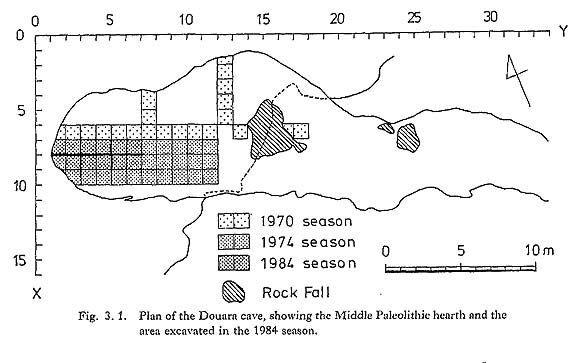
The excavation followed a 1 m × 1 m grid system (for more details, see Endo et al., 1978). Two lines of 1 m × 1 m squares (totally 11 squares) ran, and first one line (Line 8) is excavated, then the next. The first line served as control squares or pilot trench for the excavation of a previously unexcavated deposit. Each square was excavated in units 10 cm in depth, subdivided stratigraphically when discernible, as an aid in mapping as a method of designating the gross location of finds, especially from dry-sieving method at the site. Excavated sediments were screened through a ca. 2.5 mm mesh to increase recovery of smaller remains.
In addition, after an artifact had been exposed, it was mapped in a three-coordinates system (see Endo et al., 1978). This information is as important as the artifact itself, for no adequate analysis of an excavation can be made unless each artifact is accurately placed in relation to other cultural remains. Essential evidence of the extent of cultural change during the occupation of the site is provided when the horizontal and vertical locations reveal a significant clustering, in a particular area of the site deposit, of certain artifacts from which some former activity may be inferred.
Figures 3. 2 and 3. 3 show the distribution of lithic artifacts recorded in the three coordinates. Overall, flints are more abundant in the upper part of the deposits than lower down. The horizontal distribution of flints is of particular interest. The IVB flints are absent toward the back of the cave, although the succeeding IVC flints are well scattered. IVD flints concentrate at the back of the cave and are rare in front, although the IVD deposits are distributed throughout the excavated area.
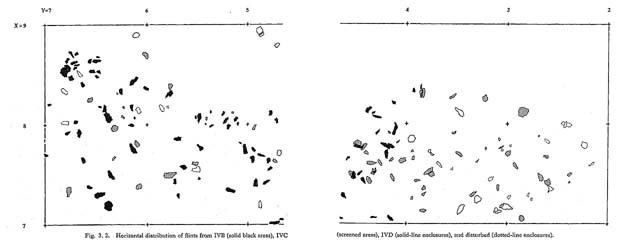
Fig.3.2 |

Fig.3.3 |
The IVB flints show a clear pattern of local concentration in the excavated area, reflected in detail by their horizontal distribution pattern. Nevertheless, IVB flints seems to be concentrated in much the same area as IVB deposits, and thus are well scattered, at least throughout the IVB deposit in the excavated area. The IVC flints, too, are well scattered in the same area as IVC deposits. In contrast, the IVD flints show a peculiar pattern of small-scale concentration within the IVD deposits
The studies of the lithic artifacts from the 1984 excavations were largely confined to typological analysis and a detailed counting of the collection. The entire artifact collection was given to the Department of Antiquities and Museums at Palmyra, where it is now stored, as the press of time in the field precludes a thorough analysis of an entire collection.
We used a new research method for duplicating flint artifacts during the field work in Palmyra. The actual work was directed by Kimura, one of the authors of this chapter. A total of 102 specimens were duplicated using gypsum. These include every tool, standardized flakes, and all cores and core fragments. These collections warrant a uniform analysis of the entire collection, including artifact samples from later field seasons.
In connection with the excavation, every possible effort has been made to use specialized techniques to extract as much information as possible from the material. This material can be placed in four major groups: artifacts, flora, fauna, and sediments. The series of studies based upon these materials are presented in this volume. With the exception of the study using the lithic material (Chapter 5 in this volume), their background, especially regarding provenance and sampling techniques, will be given below.
3.1.1 Baked earth for paleomagnetic analysis
Eight samples of baked earth were systematically cut out of the Middle Palaeolithic hearth deposit. The main objective of the study on these samples is to obtain basic data relating to the firing temperature of the hearth and absolute dates measured by the thermo-luminescence method (Chapter 8 in this volume).
The samples were cubes with sides 35 mm long. Cuts into the intact baked earth were made in two planes parallel to the magnetic north, two planes vertically at right angles to these planes, and a horizontal plane on the top of the cube. Magnetic north was N2°53'E in this district (Syrian Arab Republic, 1963). The cube was fixed to an aluminum rectangular tube by gypsum. After fixation, the base of the cube was cut horizontally.
The samples were obtained from the north-westernmost corner of the hearth. They were from Unit-columns 7-03, 8-02, 9-03 which surround Unit-column 8-03 (Figs. 3. 4, 3. 5; Plate 3. 2: a). Except for sample No. 6, all samples were cut from the baked earth which seemed to make a wall of the hearth. Sample No. 6 was obtained from an area not thoroughly excavated.
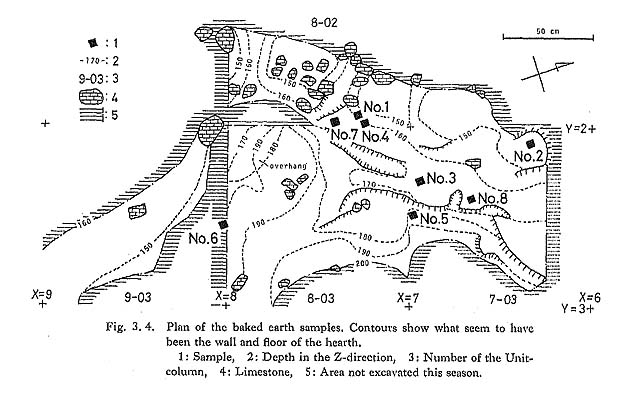

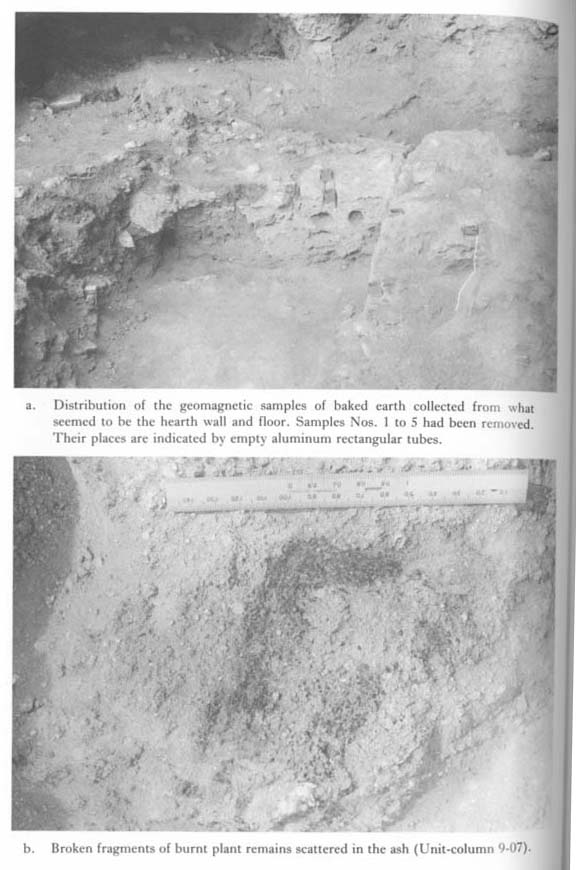
Plate 3.2 |
In the following description, the center of the base of each cube is located by the XYZ coordinates.
| No. 1. | (X, Y, Z)=(7.29, 1.935, 1.64 m). Pale red hard concreted earth. |
| No. 2. | (6.38, 2.095, 1.48 m). Pale red hard concreted earth. Probably the same layer as No. 1. |
| No. 3. | (6.94, 2.30, 1.67 m). Pale reddish-orange hard concreted earth. |
| No. 4. | (7.25, 1.98, 1.72 m). Pale reddish-gray very hard concreted earth with small pieces of rubble. |
| No. 5. | (6.98, 2.49, 1.91 m). Pale yellow hard concreted earth. |
| No. 6. | (8.02, 2.55, 1.94 m). Pale orange concreted earth with small pieces of rubble. |
| No. 7. | (7.42, 1.975, 1.68 m). Pale red hard concreted earth with small rubbles and black grain. |
| No. 8. | (6.66, 2.40, 1.68 m). Pale reddish-orange hard concreted earth. The same layer as No. 3. |
The layers of the sample would be ordered from the top: No. 2-No. 1, No. 7, No 4, No. 3-No. 8, No. 5, and No. 6.
3. 1. 2 Barite nodules for thermoluininescence analysis
Four barite nodules were collected in situ from unit IVB of the Middle Paleolithic hearth. Every piece is unshaped with a symmetrically rounded to oval outline. The size ranges from 39.2 to 47.8 mm in diameter, and from 150 to 160.5 gr in weight. It is impossible to consider that these nodules originally grew in the cave deposit, so it must be considered that the Douara inhabitants brought them from elsewhere in the Palmyra Basin (Plate 1.8: 1 in this volume).

Plate 1.8 |
Barite nodules were found in the 1974 excavations. One from the Middle Paleolithic hearth deposits, which is thought to have been burnt in the hearth fire, was dated by fission-tracking at 75,000 BP (Nishimura, 1979). This result has been on its way to becoming one of the most important dates in Levantine prehistory, and helps provide a new chrono logical framework for the earlier Levantine Mousterian to which future work can be related (Copeland, 1981).
Nevertheless, this date was obtained by only one method on one sample. Two other dating techniques have been applied to material from the 1984 excavations. One is thermo luminescence dating using barite nodules from the Middle Paleolithic hearth deposits, and the other is radiocarbon measurements using burnt plant remains associated with the hearth deposits. The report on thermoluminescence dating is included in this volume (as Chapter 9 in this volume). The provenance of the barite samples is as follows:
| No. 1. | (X, Y, Z)=(3.92, 8.88, 1.90 m) |
| No. 2. | (X, Y, Z)=(3.54, 9.05, 1.93 m) |
| No. 3. | (X, Y, Z)=(4.20, 9.05, 1.76 m) |
| No. 4. | (X, Y, Z)=(4.62, 9.08, 1.92 m) |
3. 1. 3 Plant remains for paleobotanical analysis
A square area 10 cm ×10 cm at the south-western corner of each Unit-column was used for the sampling of the earth. All earth, except the baked earth of the hearth, was collected from every vertical excavation interval of 10 cm. If different layers were in an excavation interval, then a sample of each layer was collected separately. The earth samples were used in the laboratory for physical soil analyses and for precise sampling of small animal and plant remains and artifacts.
Many burnt seeds were contained in the ash (Plate 3. 2: b; see also Chapter 7 in this volume). The black and dark brown bands were mostly carbonized plant remains, almost all of which were broken in pieces. Many plant remains were dry sieved at the cave site using a 2.5 mm mesh. In the laboratory, seeds from the earth samples obtained from the southwestern corner of each Unit-column were dry sieved using a 1 mm mesh. Samples of the carbonized plant remains were submitted for the accelerator mass spectrometry (AMS) dating method (sec Chapter 10 in this volume).
Two ash blocks containing the seeds were cut out from the sediment for detailed analyses in the laboratory. Some faces of the ash block were covered by gypsum in situ. The first block was in Unit-column 9-05 and contained Horizons IVC and IVD. The northwestern corner of the top of this block had the coordinates (8, 4, 1.90 m) (Plate 3. 3: a). The block was about 12 cm along line X, about 10 cm along line Y, and about 15 cm high. At the deepest layer of unit IVC of this block, there was a black band where the burnt seeds were very dense. The second block was in Unit-column 9-06, and contained Horizons IVB, IVC, and IVD (Plate 3. 3: b). The northwestern corner of the top had the coordinates (8, 5.22,1.93 m). This block was about 12 cm along line X, about 10 cm along line Y, and about 25 cm high. Again, the plant remains were especially dense in unit IVC.

Plate 3.3 |
Some thin layers with an area of about 40 cm× 20 cm were horizontally peeled by the lac-film method in order to preserve the horizontal distribution of plant remains. These layers were obtained from Unit-column 9-05, in the deepest layer of Horizon IVC where the seeds were densely scattered (Plate 3. 4: a).
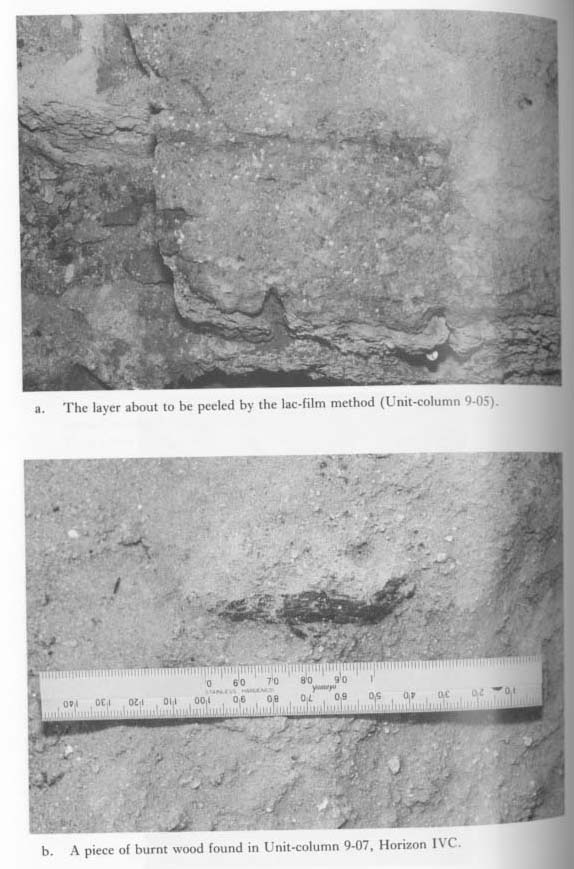
Plate 3.4 |
Only one carbonized wood piece was discovered in the ash (Plate 3. 4: b). The charcoal was in Horizon IVC, Unit-column 9-07. Identification of this sample is still underway by Gordon Hillman, London University.
LITERATURE CITED
- Copeland, L. (1981)
- Chronology and distribution of the Middle Paleolithic, as known in 1980, in Lebanon and Syria. In J. Cauvin and P. Sanlaville (eds.), Prehistoire du Levant, pp. 239-263.
- Endo, B., Fujimoto, T., Akazawa, T., and Endo, K. (1978)
- Excavation at the Douara Cave. In K. Hanihara and Y. Sakaguchi (eds.) Paleolithic Site of Douara Cave and Paleogeography of Palmyra Basin in Syria. Part I. Univ. Mus., Univ. of Tokyo, Bull. 14: 83-98.
- Nishimura, S. (1979)
- Fission-track age of the baked pebble excavated at Douara cave. In K. Hanihara and T. Akazawa (eds.), Paleolithic Site of Douara Cave and Paleogeography of Palmyra Basin in Syria. Part II. Univ. Mus., Univ. of Tokyo, Bull. 16: 235-238.
- Syrian Arab Republic (1963)
- Map 1:200,000 Tudroor (1-37-XV).
|